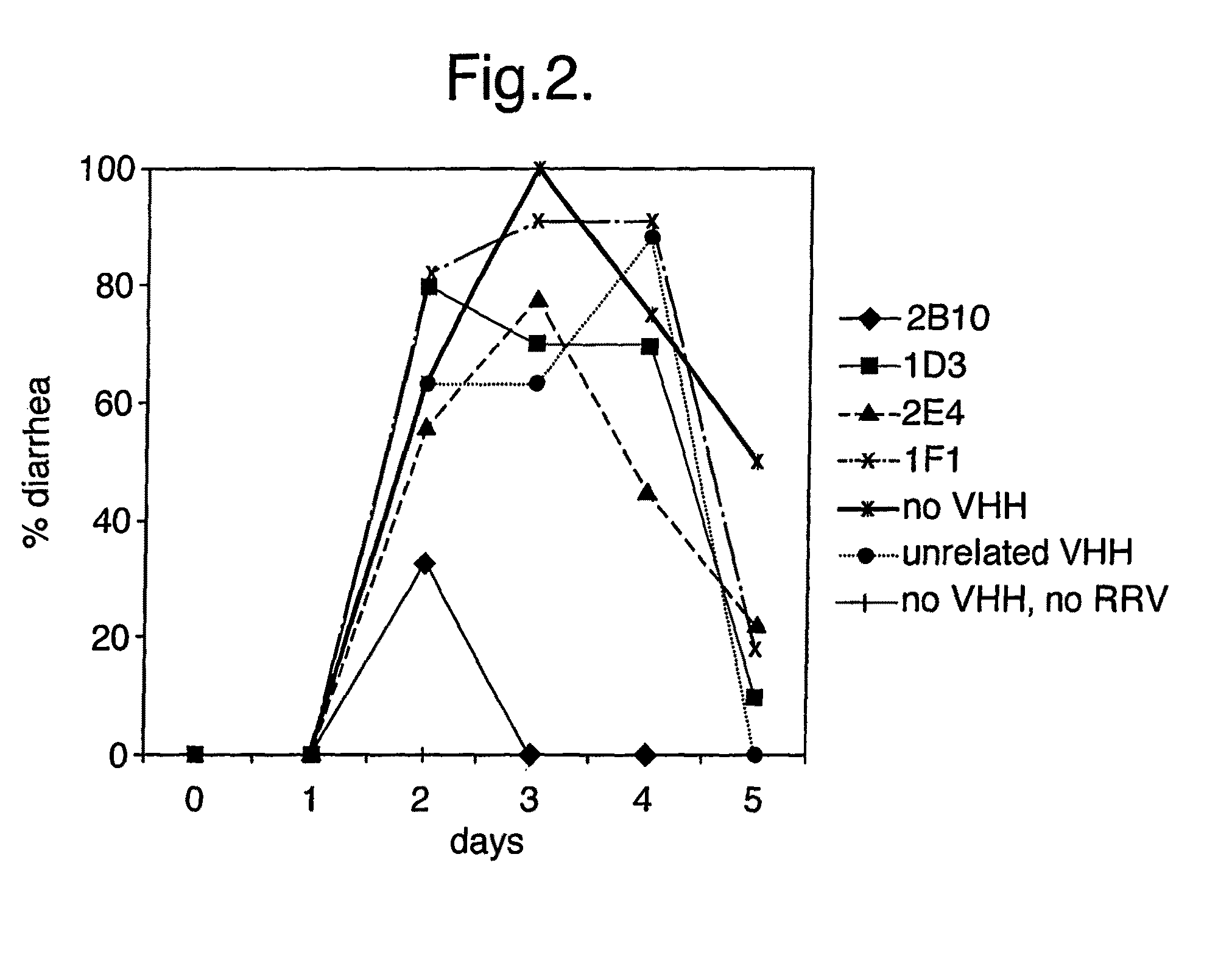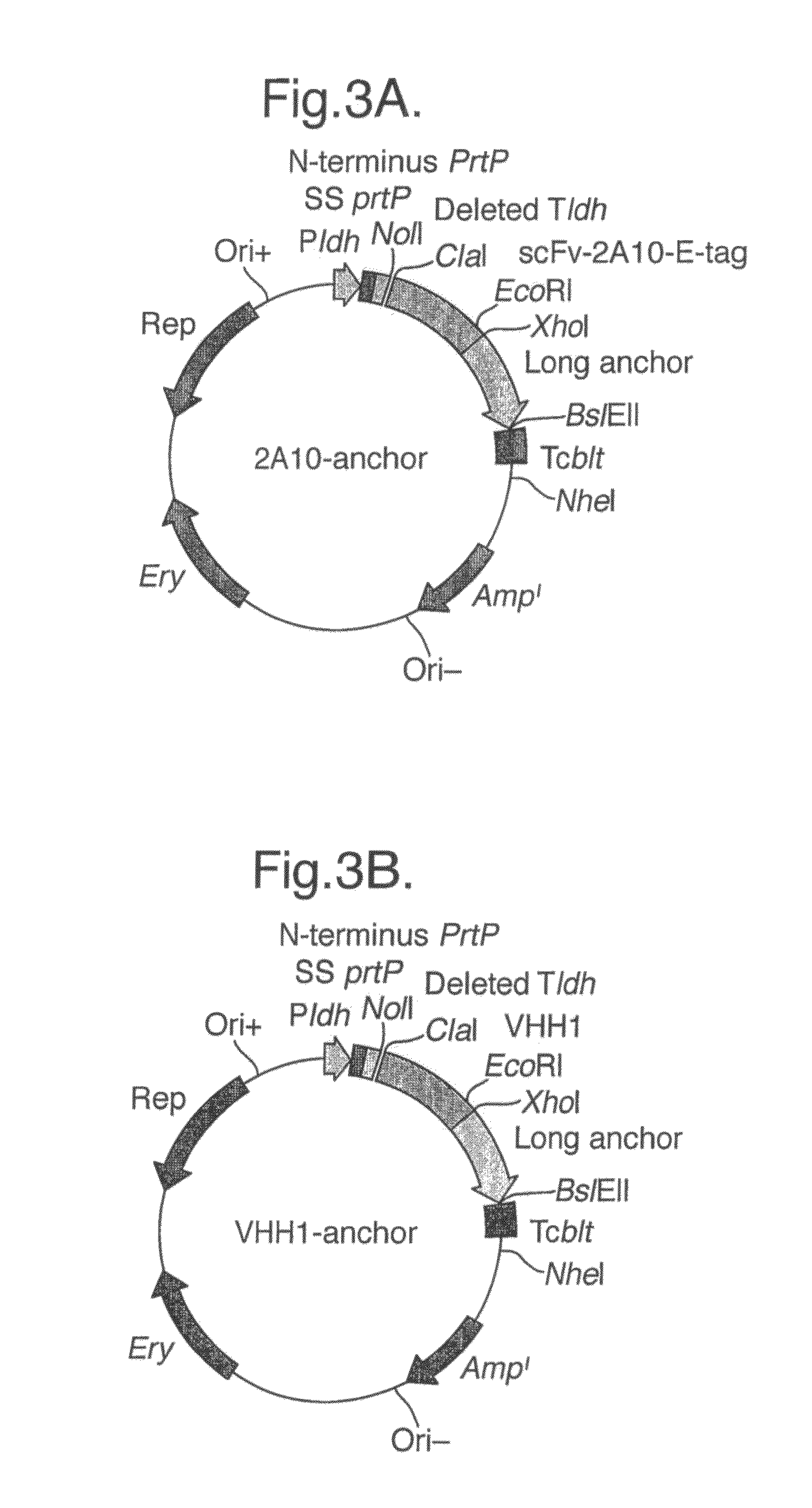Heavy chain and single domain antibodies
a single-domain, heavy-chain technology, applied in the field of heavy-chain immunoglobulins, can solve the problems of large amounts of conventional immunotherapy products, prohibitive wide-scale application of immunotherapy, and inability to meet the needs of patients, so as to reduce the viral load, reduce the burden, and improve the effect of health
- Summary
- Abstract
- Description
- Claims
- Application Information
AI Technical Summary
Benefits of technology
Problems solved by technology
Method used
Image
Examples
example 1
[0217]Selection of Rotavirus Specific Heavy-Chain Antibody Fragments from a Llama Immune Phage Display Library and Production in Yeast.
[0218]Rhesus rotavirus strain RRV (serotype G3) was purified, amplified and concentrated as described previously (Svensson L., Finlay B. B., Bass D., Vonbonsdorff C. H., Greenberg H. B. “Symmetrical infection on polarised human intestinal epithelial (CaCo-2) cells”. J Virol. (1991) 65, 4190-4197.
[0219]A llama was immunized subcutaneously and intramuscularly at day 0, 42, 63, 97 and 153 with 5×1012 pfu of rotavirus strain RRV.
[0220]Prior to immunization, the viral particles were taken up in oil emulsion (1:9 V / V, antigen in PBS: Specol (Bokhout, B. A., Van Gaalen, C., and Van Der Heijden, Ph. J. “A selected water-in-oil emulsion: composition and usefulness as an immunological adjuvant”. Vet. Immunol. Immunopath. (1981) 2: 491-500 and Bokhout, B. A., Bianchi, A. T. J., Van Der Heijden, Ph. J., Scholten, J. W. and Stok, W. “The influence of a water-in-o...
example 2
[0232]In Vitro Inhibition of Rotavirus
[0233]Bovine Rotavirus Compton CK5 was obtained from the Moredun Institute, Midlothian, Scotland and the BS-C1 cells were purchased from the European Animal Cell Culture Collection.
[0234]The BS-C1 cells were cultured in Earles Modified Essential Medium supplemented with 10% Heat inactivated foetal calf serum, 1% MEM Amino Acids solution (100×), 20 mmol 1-1 L-Glutamine, 100 I.U. ml-1 penicillin, 100 μg ml-1 streptomycin and 2.5 μg ml-1 amphotericin B (all from Sigma, US).
[0235]CK5 Rotavirus stock was diluted in Serum Free Medium (SFM) EMEM supplemented with 1% MEM Amino Acids solution (100×), 20 mmol 1-1 L-Glutamine and 0.5 μg / ml crystalline trypsin and then 5 ml of diluted seed was added to confluent monolayers of BS-C1 cells in 162 cm2 tissue culture flasks (Costar, UK). The virus was adsorbed onto the cells for one hour at 37° C. then the medium was topped up to 75 ml. The bottles were incubated at 37° C. until complete cytopathic effect was o...
example 3
[0241]In Vivo Rotavirus Inhibition in Mice
[0242]Some of the VHH fragments selected via the approach described in example 2 were used in in vivo experiments to study the efficacy of these antibody fragment in the prevention or treatment of rotavirus induced diarrhoea in mice. This model system has been frequently used for study of rotavirus infection (Ebina, T, Ohta, M, Kanamaru, Y, Yamamotoosumi, Y, Baba, K. “Passive immunisations of suckling mice and infants with bovine colostrum containing antibodies to human rotavirus”. J Med Virol. (1992) 38: 117-123).
[0243]14 days pregnant, rotavirus negative BALB / c mice were obtained from Möllegård, Denmark. The mice were housed individually in the animal facility at Huddinge Hospital. Approval was obtained from the local ethical committee of Karolinska Institute at Huddinge Hospital, Sweden. Normal pellet diet and water was provided ad libitum.
[0244]In order to examine whether the fragments can inhibit infection when bound to rotavirus (RV), ...
PUM
 Login to View More
Login to View More Abstract
Description
Claims
Application Information
 Login to View More
Login to View More - R&D
- Intellectual Property
- Life Sciences
- Materials
- Tech Scout
- Unparalleled Data Quality
- Higher Quality Content
- 60% Fewer Hallucinations
Browse by: Latest US Patents, China's latest patents, Technical Efficacy Thesaurus, Application Domain, Technology Topic, Popular Technical Reports.
© 2025 PatSnap. All rights reserved.Legal|Privacy policy|Modern Slavery Act Transparency Statement|Sitemap|About US| Contact US: help@patsnap.com



